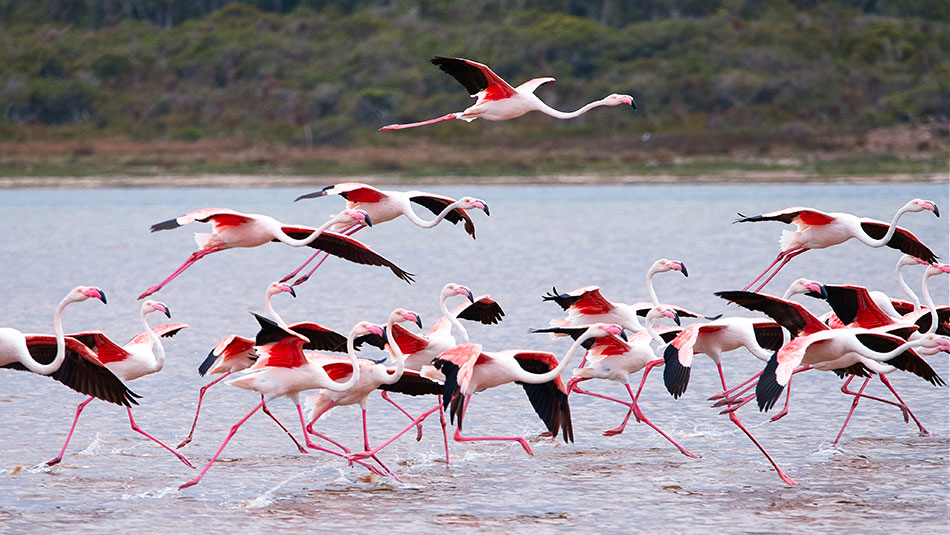
Flamingos, with their long, agile legs, radiant pink tone, and weird downturned snouts, are a famous sight whether at zoos, in narratives, or even in nature. Watching them stepping through the water, clearing their snouts through it to take care of, can without much of a stretch hypnotize you. It absolutely seems like any time we see flamingos, they’re on the ground or remaining in the water, not noticeable all around. This makes one wonder, would flamingos be able to fly?
CAN FLAMINGOS FLY?
Indeed, flamingos can fly. Truth be told, not normal for some different birds which invest the vast majority of their energy on the ground, flamingos really will more often than not fly at exceptionally high heights and can fly for significant distances. Flamingos can fly to the extent that 375 miles in a single evening, hitting a normal speed of 35mph and flying as high as 15,000 feet over the ground.
Flamingos are a gathering of swimming birds with various species, spread all through the Americas, the Caribbean, Africa, Asia, and even Europe. The name “flamingo” is gotten from an old Portuguese word that signifies “fire shaded,” regarding their radiant pink, regularly red tinge.
That well-known shading comes from their eating routine, which is wealthy in saline solution shrimp and green growth. Flamingos in imprisonment are regularly white on the grounds that their eating routine comes up short on the important shades to shading them pink. Indeed, all of the shading variety between the flamingo species can be ascribed to contrasts in diet, with the species eating the biggest measures of blue-green growth having the haziest tinge.
ARE FLAMINGOS A FLIGHTLESS BIRDS?
As we’ve as of now referenced, flamingos are not flightless birds. Truth be told, they aren’t even firmly identified with birds like turkeys, chickens, or peacocks that live essentially on the ground and are equipped for restricted flight. Flamingos have a place with the family Phoenicopteridae, and they are the main bird in that family.
While they are swimming birds, other swimming birds are not direct relations by the same token. Indeed, even birds like the roseate spoonbill, which ostensibly looks similar to a flamingo, aren’t connected. Truth be told, the nearest comparative with the flamingo is the grebe, which looks in no way like them.
This to say, flamingos are able to do since quite a while ago, supported trips at high paces despite the fact that they consume a lot of their time on earth on the ground and in the water. Hostage flamingos must have their wings cut to forestall escape, and in no less than one case a flamingo in a zoo in Kansas got away, traveled to Louisiana and afterward to Texas, and still lives in the wild there.
WHY DON’T WE SEE FLYING FLAMINGOS MORE OFTEN?
Since we quite often notice them on the ground, you might be asking why we seldom see flamingos noticeable all around. The appropriate response is that they will more often than not fly at high heights typically 10,000 feet up or higher, and their pink or red tones don’t effectively appear in the sky from that distance. Contingent upon where you reside, there’s a decent possibility you’ve really checked out a group of flying flamingos and couldn’t spot them.
For what reason does FLAMINGOS FLY?
Flamingos are anything but genuine transitory animal category, however, they actually fly as often as possible. They will migrate because of climate changes, water level changes, or changes to the food supply. These aren’t movements in the customary sense, however they do happen regularly. Flamingos don’t care for particularly chilly climates and they lean toward shallow water.
They’ll likewise fly in case they’re upset and feel undermined, albeit ordinarily in these cases they just fly not far off, just to the nearest lake or tidal pond.
HOW DO FLAMINGOS TAKE OFF?
Flamingos don’t resemble an animal that would have the option to make headway and fly effectively, with their long dainty necks and legs, so how would they take off? Flamingos have a particular take-off design that assists them with making headway.
They start by fluttering their wings quickly, and afterward taking fast, running advances or rowing in the water to develop speed and assist them with taking off. Like a plane, flamingos need somewhat of a runway to take off and get airborne.


